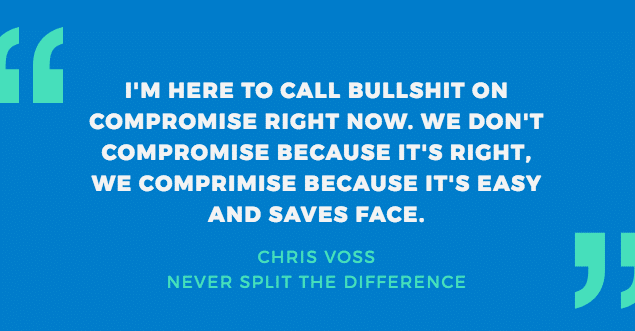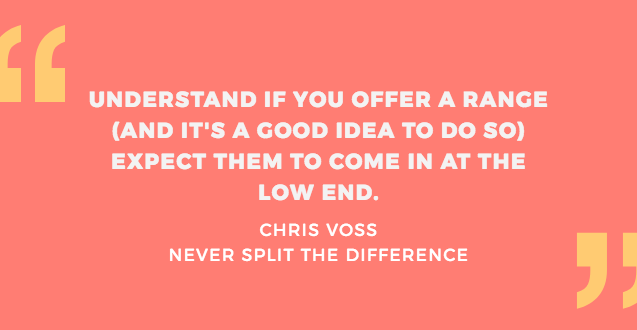This article will cover how to negotiate by using the tactics from Chris Voss’s book, Never Split the Difference. This is part one of a two-part series on how to negotiate with venture capitalists and prospects.
Sammy is a co-founder of Blossom Street Ventures. We invest in companies with run rate revenue of $2mm+ and year over year growth of 50%+. We can commit in 3 weeks and our check is $1mm. Email Sammy directly at sammy@blossomstreetventures.com.
I just read a book called Never Split the Difference by Chris Voss. Chris was one of the premiere FBI hostage negotiators in the world, and his tactics could be useful for learning how to negotiate with VCs, customers, and vendors. Below is a continuation of a recent blog post about the book. The original blog we wrote highlighted some of the key excerpts of the first half of the book. Below are excerpts from the second half on how to negotiate.
Compromising Should Not Be the Default
“I’m here to call bullshit on compromise right now. We don’t compromise because its right, we compromise because it is easy and because it saves face. So don’t settle and — here’s a simple rule — never split the difference. Creative solutions are almost always preceded by some degrees of risk, annoyance, confusion, and conflict. Accommodation and compromise produce none of that. You’ve got to embrace the hard stuff. That’s where the great deals are.”


Wait Until the End of the Period
“Car dealers are prone to give you the best price near the end of the month when their transactions are assessed. And corporate salespeople work on a quarterly basis and are most vulnerable as the quarter comes to a close.”
Be Open About Deadlines
“Moore discovered that when negotiators tell their counterparts about their deadline, they get better deals. It’s true. First, by revealing your cutoff you reduce the risk of an impasse. And second, when an opponent knows your deadline, he’ll get to the real deal and concession-making point more quickly.”
Perceived Unfairness Will Kill a Deal
“In a TV interview, former Iranian nuclear negotiator Seyed Hossein Mousavian hit the nail on the head. ‘The nuclear issue today for Iranians is not nuclear,’ he said, ‘it’s defending their integrity [as an] independent identity against the pressure of the rest.’ You may not trust Iran, but its moves are pretty clear evidence that rejecting perceived unfairness, even at a substantial cost, is a powerful motivation.”
They Have Something to Lose
“In a tough negotiation, it’s not enough to show the other party that you can deliver the thing they want. To get real leverage, you have to persuade them that they have something concrete to lose if the deal falls through.”
Let Them Offer First, but Be Ready
“By letting them anchor you also might get lucky: I’ve experienced many negotiations when the other party’s first offer was higher than the closing figure I had in mind. If I’d gone first they would have agreed and I would have left with either the winner’s curse or buyer’s remorse, those gut-wrenching feeling that you’ve overpaid or undersold.
That said, you’ve got to be careful when you let the other guy anchor. You have to prepare yourself psychically to withstand the first offer. If the other guy’s a pro, a shark, he’s going to go for an extreme anchor in order to bend your reality. Then, when they come back with a merely absurd offer it will seem reasonable after they mark it down from a crazy $600.”
Don’t Get a Reputation for Being Too Good
“Here’s my personal advice on whether or not you want to be the shark that eats a rookie counterpart. Just remember, your reputation precedes you. I’ve run into CEOs whose reputation was to always badly beat their counterpart and pretty soon no one would deal with them.”
Offering a Range
“Understand, if you offer a range (and it’s a good idea to do so) expect them to come in at the low end.”


Be Specific
“The biggest thing to remember is that numbers that end in 0 inevitably feel like temporary placeholders, guesstimates that you can easily be negotiated off of. But anything you throw out that sounds less rounded — say, $37,263 — feels like a figure that you came to as a result of a thoughtful calculation. Such numbers feel serious and permanent to your counterpart, so use them to fortify your offers.”
Give the Illusion of Control
“From the ashes of Dos Palmas, then, we learned a lesson that would forever change how the FBI negotiated kidnappings. We learned that negotiation was coaxing not overcoming; co-opting, not defeating. Most important, we learned that successful negotiation involved getting your counterpart to do the work for you and suggest your solution himself. It involved giving him the illusion of control while you, in fact, were the one defining the conversation.”
Ask Open-Ended Questions
“Instead of asking some closed-ended question with a single correct answer, he’d asked an open-ended, yet calibrated one that forced the other guy to pause and actually think about solve the problem.”
Be Broad
“When you go into a store, instead of telling the salesclerk what you “need,” you can describe what you’re looking for and ask suggestions. “
Use A “How” Question Instead of Saying “No”
“The trick to ‘How’ questions is that correctly used, they are gentle and graceful ways to say ‘No’ and guide your counterpart to develop a better solution — your solution. A gentle How/No invites collaboration and leaves your counterpart with a feeling of having been treated with respect.”
Listen to Everything
“Body language and tone of voice — not words — are our most powerful assessment tools. That’s why I’ll often fly great distances to meet someone face-to-face, even when I can say much of what needs to be said over the phone.”
How to Negotiate and Be Friendly
“I asked her if I got a discount for joining and she said, ‘No.’ So I decided to try another angle. I said in a friendly manner, ‘My name is Chris. What’s the Chris discount?’ Humanize yourself. Use your name to introduce yourself. Say it in a fun, friendly, way. Let them enjoy the interaction, too. And get your own special price.”
Lead with Extreme Anchoring
“Experienced negotiators often lead with a ridiculous offer, an extreme anchor. And if you’re not prepared to handle it, you’ll lose your moorings and immediately go to your maximum. It’s human nature. Like the great ear-biting pugilist Mike Tyson once said, ‘Everybody has a plan until they get punched in the mouth.'”
Reduce the Size of Your Counteroffers Each Time
“Second, the diminishing size of the increases — notice that they decrease by half each time — convinces your counterpart that he’s squeezing you to the point of breaking. By the time they get to the last one, they’ll feel that they’ve really gotten every last drop.”
Lessons on How to Negotiate with VCs
If you’re going to throw out a valuation, use a range but expect the VC to anchor himself for the bottom of the range. As such, the valuation you’re happy with needs to be at the bottom of the range. If you let the VC throw out the first valuation, that’s great, but be prepared for them to set a very low anchor.
Don’t be offended — it’s just negotiation.
Reduce the size of counteroffers each time so the other party thinks they’re squeezing you, and use specific numbers that have real math behind them. Specific numbers are appreciated while round numbers are dismissed.




